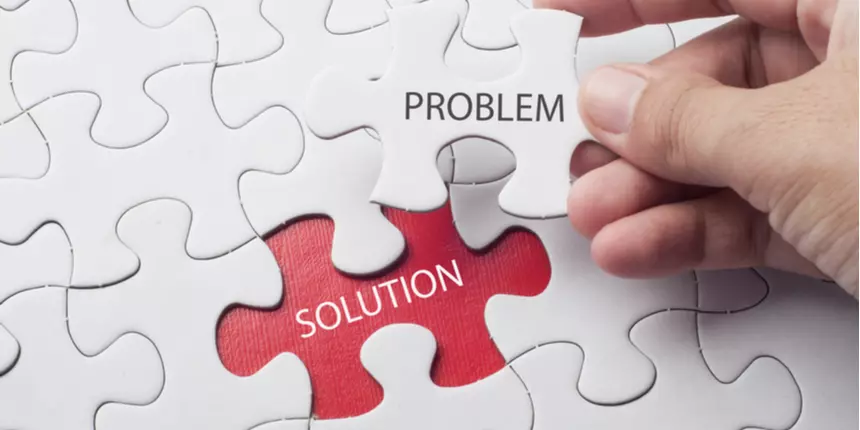Apply to Aakash iACST Scholarship Test 2024
Chapter 13 class 10 maths NCERT solutions Excercise: 13.1
Q1 2 cubes each of volume 64 cm 3 are joined end to end. Find the surface area of the resulting cuboid.
Answer:
We are given that volume of the cube
Also, the volume of a cube is given by ( here
is the edge of the cube)
Thus :
Now according to the question we have combined the two cubes that edge lengths of the formed cuboid are 4 cm, 4 cm, and 8 cm.
The surface area of a cuboid is :
or
or
or
Thus the area of the formed cuboid is 160 cm 2 .
Answer:
Since the vessel consists of hemisphere and cylinder, thus its area is given by :
Area of vessel = Inner area of the cylinder(curved) + Inner area of hemisphere
The inner surface area of the hemisphere is :
or
or
And the surface area of the cylinder is :
or
or
Thus the inner surface area of the vessel is
Answer:
The required surface area of the toy is given by :
Area of toy = Surface area of hemisphere + Surface area of the cone
Firstly consider the hemisphere :
The surface area of a hemisphere is
or
or
Now for cone we have :
The surface area of a cone
Thus we need to calculate the slant of the cone.
We know that :
or
or
or
Thus surface area of a cone
or
or
Hence the total surface area of toy =
Answer:
It is given that the hemisphere is mounted on the cuboid, thus the hemisphere can take on complete as its diameter (which is maximum).
Thus the greatest diameter of the hemisphere is 7 cm.
Now, the total surface area of solid = Surface area of cube + Surface area of the hemisphere - Area of the base of a hemisphere (as this is counted on one side of the cube)
The surface area of the cube is :
Now the area of a hemisphere is
And the area of the base of a hemisphere is
Hence the surface area of solid is .
Answer:
It is given that the diameter of the hemisphere is equal to the edge length of the cube.
The total surface area of solid is given by :
The surface area of solid = Surface area of cube + Surface area of the hemisphere - Area of the base of the hemisphere
The surface area of the cube
And surface area of the hemisphere:
Area of base of the hemisphere:
Thus the area of solid is:

Answer:
It is clear from the figure that the capsule has hemisphere and cylinder structure.
The surface area of capsule = 2 (Area of the hemisphere) + Area of the cylindrical part
Area of hemisphere
or
or
And the area of the cylinder
or
or
Thus the area of the solid is :
Answer:
The canvas will cover the cylindrical part as well as the conical part.
So, the area of canvas = Area of cylindrical part (curved) + Area of the conical part
Now, the area of the cylindrical part is
or
or
And the area of the cone is
or
or
Thus, the area of the canvas
or
Further, it is given that the rate of canvas per m 2 is = Rs. 500.
Thus the required money is
Answer:
Firstly we need to calculate the slant height of the cone :
or
or
or
Now, the total surface area of solid can be calculated as :
The surface area of solid = Surface area of cylinder + Surface area of cone + Area of base of the cylinder
The surface area of the cylinder is
or
or
Now, the surface area of a cone
or
or
And the area of the base of the cylinder is
or
or
Thus required area of solid = 10. 56 + 5.50 + 1.54 = 17.60 cm 2 .
Thus total surface area of remaining solid to nearest cm 2 is 18 cm 2 .
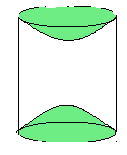
Answer:
The required surface area is given by :
The surface area of article = Surface area of cylindrical part + 2 (Surface area of the hemisphere)
Now, the area of the cylinder
or
or
And the surface area of the hemisphere :
or
or
Thus the required area
Chapter 13 class 10 maths NCERT solutions Excercise: 13.2
Answer:
The volume of the solid is given by :
The volume of solid = Volume of cone + Volume of a hemisphere
The volume of cone :
or
or
And the volume of the hemisphere :
or
or
Hence the volume of solid is :
Answer:
The volume of air present = Volume of cylinder + 2 (Volume of a cone)
Now, the volume of a cylinder :
or
or
And the volume of a cone is :
or
or
Thus the volume of air is :
or
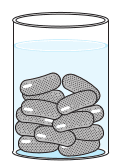
Answer:
It is clear from the figure that gulab jamun has one cylindrical part and two hemispherical parts.
Thus, the volume of gulab jamun is = Volume of cylindrical part + 2 (Volume of the hemisphere )
Now, the volume of the cylinder is
or
or
And the volume of a hemisphere is :
Thus the volume of 1 gulab jamun is
Hence the volume of 45 gulab jamun
Further, it is given that one gulab jamun contains sugar syrup upto
.
So, the total volume of sugar present :
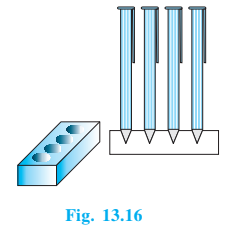
Answer:
The volume of wood is given by = volume of the cuboid - the volume of four cones.
Firstly, the volume of cuboid :
or
or
And, the volume of cone :
Thus the volume of wood is
Answer:
According to the question :
Water spilled from the container = Volume of lead balls.
Let us assume the number of lead balls to be n.
Thus the equation becomes :
or
or
or
Hence the number of lead shots dropped is 100.
Answer:
The pole can be divided into one large cylinder and one small cylinder.
Thus, the volume of pole = volume of large cylinder + volume of a small cylinder
or
or
or
or
Now, according to question mass of the pole is :
or
Answer:
It is clear from the question that the required volume is :
The volume of water (left) =Volume of a cylinder - Volume of solid
Now the volume of the cylinder is
or
And the volume of solid is :
Thus the volume of water left :
Answer:
The volume of the vessel is given by :
The volume of vessel = Volume of sphere + Volume of the cylindrical part
Now, the volume of the sphere is :
And the volume of the cylinder is:-
Thus the volume of the vessel is
NCERT solutions for class 10 maths chapter 13 Surface Areas and Volumes Excercise: 13.3
Answer:
Let us assume the height of the cylinder to be h.
Since the material is melted and recast thus its volume will remain the same.
So, Volume of sphere = Volume of obtained cylinder.
Hence the height of the cylinder is 2.74 cm.
Answer:
According to the question, small spheres are melted and converted into a bigger sphere. Thus the sum of their volume is equal to the volume of the bigger sphere.
The volume of 3 small spheres = Volume of bigger sphere
Let us assume the radius of the bigger sphere is r.
Hence the radius of the sphere obtained is 12 cm.
Answer:
According to the question, the volume of soil dug will be equal to the volume of the platform created.
Thus we can write :
The volume of soil dug = Volume of platform
Thus the height of the platform created is 2.5 m.
Answer:
According to the question, the volume is conserved here :
The volume of soil dug out = Volume of the embankment made.
Let the height of the embankment is h.
Hence the height of the embankment made is 1.125 m.
Answer:
Let the number of cones that can be filled with ice cream be n.
Then we can write :
The volume of a cylinder containing ice cream = n ( volume of 1 ice cream cone )
Hence the number of cones that can be filled is 10.
Answer:
Let us assume the number of coins that need to be melted be n.
Then we can write :
The volume of n coins = Volume of cuboid formed.
Thus the required number of coins is 400.
Answer:
According to question volume will remain constant thus we can write :
The volume of bucket = Volume of heap formed.
Let the radius of heap be r.
And thus the slant height will be
Hence the radius of heap made is 36 cm and its slant height is .
Answer:
Speed of water is: 10 Km/hr
And the volume of water flow in 1 minute is :
Thus the volume of water flow in 30 minutes will be :
Let us assume irrigated area be A. Now we can equation the expression of volumes as the volume will remain the same.
Thus the irrigated area is .
Answer:
Area of the cross-section of pipe is
Speed of water is given to be = 3 km/hr
Thus, the volume of water flowing through a pipe in 1 min. is
Now let us assume that the tank will be completely filled after t minutes.
Then we write :
Hence the time required for filling the tank completely in 100 minutes.
NCERT Solutions for class 10 Maths volume and surface area Excercise: 13.4
Answer:
The capacity of glass is the same as the volume of glass.
Thus the volume of glass :
= Capacity of glass
Answer:
We are given the perimeter of upper and lower ends thus we can find r 1 and r 2 .
And,
Thus curved surface area of the frustum is given by :
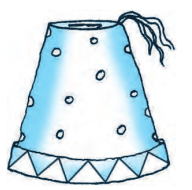
Answer:
The area of material used is given by :
Area of material = Curved surface area of a frustum of cone + Area of upper end
Answer:
Firstly we will calculate the slant height of the cone :
Now, the volume of the frustum is :
= Capacity of the container.
Now, the cost of 1-liter milk is Rs. 20.
Then the cost of 10.449-liter milk will be
The metal sheet required for the container is :
Thus cost for metal sheet is
Answer:
The figure for the problem is shown below :
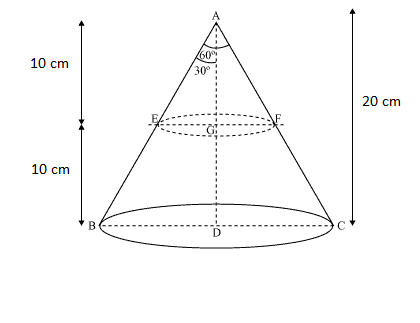
Using geometry we can write :
and
Thus the volume of the frustum is given by :
Now, the radius of the wire is :
Thus the volume of wire is given by :
Now equating volume of frustum and wire, we get :
Thus the length of wire drawn is 7964.44 m.
NCERT solutions for class 10 CBSE maths surface area and volume Excercise: 13.5
Answer:
A number of rounds are calculated by :
Thus the length of wire in 40 rounds will be
And the volume of wire is: Area of cross-section Length of wire
Hence the mass of wire is.
Answer:
The volume of the double cone will be = Volume of cone 1 + Volume of cone 2.
(Note that sum of heights of both the cone is 5 cm - hypotenuse).
Now the surface area of a double cone is :
Answer:
The total volume of the cistern is :
And the volume to be filled in it is
Now let the number of bricks be n.
Then the volume of bricks :
Further, it is given that brick absorbs one-seventeenth of its own volume of water.
Thus water absorbed :
Hence we write :
Thus the total number of bricks is 1792.
Answer:
Firstly we will calculate the volume of rainfall :
Volume of rainfall :
And the volume of the three rivers is :
It can be seen that both volumes are approximately equal to each other.
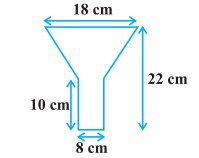
Answer:
From this, we can write the values of both the radius (upper and lower) and the height of the frustum.
Thus slant height of frustum is :
Now, the area of the tin shed required :
= Area of frustum + Area of the cylinder
Answer:
In the case of the frustum, we can consider:- removing a smaller cone (upper part) from a larger cone.
So the CSA of frustum becomes:- CSA of bigger cone - CSA of the smaller cone
And the total surface area of the frustum is = CSA of frustum + Area of upper circle and area of lower circle.
Answer:
Similar to how we find the surface area of the frustum.
The volume of the frustum is given by-
=Volume of the bigger cone - Volume of the smaller cone
